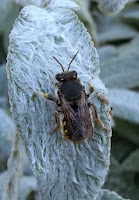July 6, 2013
I tend to favor beetles (Coleoptera) as my favorite order of insects. Of those, I believe that Curculionids (weevils) are some of the "cutest" of the beetles. Here are a few that I have come across in the past couple of months with a brief description:
This is
Sphenophorus cicatristriatus, the Denver or Rocky Mountain billbug. I found these adults roaming around in a client's yard about 6-weeks ago. The larvae of these insects can be damaging to turf in the summer months. Their damage looks nearly identical to drought stress. Tugging on the dry grass is a quick and rough test to check for damage- the grass pulls up with relative ease and the stems are noticeably chewed on.
This is
Otiorhynchus sulcatus, the black vine weevil. I was lucky to see this adult out and about as they are largely nocturnal. Originally from europe, this common pest's damage can be seen on the Peony leaves in the background. Additionally, it's larvae are damaging to the roots. To top it off, these beetles feed on upwards of 100 different species of ornamental plants.
This is
Rhynchites bicolor, the rose curculio weevil. I happened to see it feeding on a client's rose bush, and it held still in my hand just long enough for a photo op before flying away. The adults damage rose buds by feeding on them, the calyx, and peduncle. Additionally, they will lay eggs in deep inside these buds, where the larvae hatch and feed on the reproductive parts of the plant.
This is
Eustenopus villosus, the hairy yellow star thistle weevil. It is an introduced biological control agent on yellow star thistle. My wife noticed it on my shirt while unloading groceries from the car. The adults chew holes in mature seed-heads on the thistles, lay eggs inside, and seal it. The larvae hatch and feed on the developing seeds, destroying most, if not all of them in the process.






















